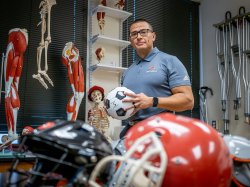Top 3 Safety Tips for Student-Athletes As They Head Back to Practice, School
Kinesiology professor offers warnings and advice for concussions, heat exposure and lightning strikes
Posted in: College for Community Health, University

Even before they go back to school this fall, millions of high school and college students will return to athletic fields to begin preseason workouts and sports practices. For student-athletes and their parents, safety is key.
The top 3 things to keep in mind, particularly with contact sports such as football and soccer, are concussions, as well as heat and lightning safety, says Montclair State University’s Luis Torres, assistant professor of Kinesiology.
Here are Torres’ Top 3 areas of concern and tips for how to deal with each:
1. Concussions – Baseline testing is a must
With growing awareness of the long-term effects of repeated concussions in professional football and boxing, there’s an added emphasis on safety, proper equipment and what to do in the event of head injuries. But there’s an important step that a student-athlete can take even before setting foot on the field, says Torres.
“The best thing that can be done is some level of baseline testing,” he says. “Baseline testing allows athletic trainers and other healthcare providers to compare the athlete’s symptoms to their own baseline in the event of a concussion or head injury later on.”
Baseline testing is increasingly recommended by athletic trainers and should be part of annual physician-administered pre-participation physical exams required for medical eligibility forms, says Torres. The professor, in collaboration with August M. Price, has previously explored the effectiveness of a popular concussion test in both healthy and concussed populations.
Many schools will offer baseline testing such as imPACT testing, Torres says.
“The more detailed information you can get during preseason, when it comes to concussions, the more information will be available for the athletic trainer and/or the team (or family) physician to get a better understanding of how a concussion is healing,” Torres says.
2. Heat Safety for Outdoor Sports
With a warming planet resulting in record-breaking heat, student-athletes need to be worried about heat-related illnesses, such as heat stroke and heat exhaustion, when practicing outdoors. Torres says many states now mandate how long student-athletes can practice, depending on air temperature and humidity.
“A combination of those two dictates the level of heat safety and how much they can practice and how many mandatory water breaks they have on that day,” he says. He advises athletes and parents to inquire about state guidelines and adherence by school personnel.
He also recommends that athletes and parents understand the presence of the athletic trainer’s heat illness Emergency Action Plan (EAP), which they are required to have, make coaches aware of and display.
3. Lightning Safety
Lightning strikes kill 20-30 people and injure hundreds more annually in the United States, according to the National Oceanic and Atmospheric Administration. Student-athletes should know lightning safety – the National Weather Service recommends staying off phones and electronic devices and avoiding concrete, for example – and what to do in the event of a lightning strike.
In addition, Torres says it’s important for parents to feel secure in their student-athletes’ healthcare providers’ ability to answer specific questions about dealing with concussion, heat exposure, lightning, cardiac arrest and other emergencies. “If someone hits their head, stands up, and they’re dizzy and nauseous, what’s the plan? If someone hits their head, their neck starts hurting, and they can’t move, what’s the plan? If someone goes unresponsive, what’s the plan?” Torres says. “When it comes to contact sports, the best thing is safety and preventing an injury, of course, and immediate and appropriate care if needed.”
I’m a ______, tell me more…
Prospective Student / Parent: Interested in Kinesiology? Learn more about the program, plan a visit to our campus and take the first step in applying to become a Red Hawk!
Journalist: Contact the Media Relations team for assets or to schedule an interview about this topic. See our Faculty Experts and hi-res media assets available for download.
